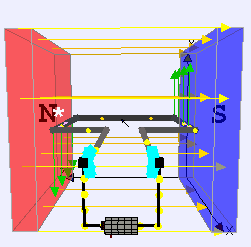ELECTRIC CURRENT :
If electric charges such as electrons, ions, charged particles flows we say that there exist an electric current.Consider a cell is connected to a torch bulb through metallic wires and a switch. On switching on the circuit, electric current is produced which flow through the wire and filament of the torch bulb, heat it up and the filament begins to glow.
Here in this case, electrons starts flowing when the cell was connected to the torch bulb through wires and switch. This flow of electrons in the metallic wire constitute the electric current.
Definition OF Electric Current:
Electric current is defined as the rate of flow of charge flowing through a cross-section of a wire/conductor.
Formula: If a net charge Q, flows across any cross-section of a conductor in time t, then the current I, through the cross-section is
\[I = \frac{Q}{t}\]
SI Unit :
The SI unit of electric charge is coulomb (C) and time is second (s). Thus the SI unit of electric current is coulomb/second (C/s). This unit is given a special name called ampere (A), named after the French scientist, Andre-Marie Ampere (1775–1836).
Definition of 1 ampere :
One ampere is that amount of current when an electric charge of one coulomb flows through a cross section of wire in one second. That is,
\[1A=\frac{1C}{1s}\]
Small units of electric current:
Small quantities of current are expressed in
(i) milliampere
Device used to measure current :
(i) milliampere
\[1mA=10^{-3}A\]
(ii) microampere
\[μA=10^{-6}A\]
An instrument called ammeter measures electric current in a circuit.
Symbol:
Connection in circuit:
It is always connected in series in a circuit through which the current is to be measured.
The Red terminal (positive terminal) is connected to the positive terminal of the battery and black terminal (negative terminal) is connected to the negative of the battery.
Direction of electric current :
Conventionally, in an electric circuit the direction of electric current is taken as opposite to the direction of the flow of electrons, which are negative charges. In an electric circuit electric current flows from the positive terminal of the cell to the negative terminal of the cell through the bulb and ammeter.
Electric circuit :
A continuous and closed path of an electric current is called an electric circuit.
Electric switch :
A switch makes a conducting link between the cell and the bulb. If the switch of the circuit is turned off, the current stops flowing and the bulb does not glow.
Charge of an electron:
NOW CHECK YOUR PROGRESS!!!
1. What does an electric circuit mean?
2. Define the unit of current.
3. Calculate the number of electrons constituting one coulomb of charge.
4. A current of 0.5 A is drawn by a filament of an electric bulb for 10 minutes. Find the amount of charge that flows through the circuit.
5. Name the instrument used to measure electric current in a circuit. How is this instrument connected in a circuit? Draw a simple circuit diagram to explain your answer.
6. Which particles constitute electric current in a metallic conductor?
7. Name two units for expressing the small values of current. Also write their symbols. How are these units related to ampere?
8. Write the use of following components in an electric circuit
(a) Cell/battery
(b) Ammeter
(c) Connecting wires
(d) Switch/plug key
The Red terminal (positive terminal) is connected to the positive terminal of the battery and black terminal (negative terminal) is connected to the negative of the battery.
Direction of electric current :
Conventionally, in an electric circuit the direction of electric current is taken as opposite to the direction of the flow of electrons, which are negative charges. In an electric circuit electric current flows from the positive terminal of the cell to the negative terminal of the cell through the bulb and ammeter.
Electric circuit :
A continuous and closed path of an electric current is called an electric circuit.
Electric switch :
A switch makes a conducting link between the cell and the bulb. If the switch of the circuit is turned off, the current stops flowing and the bulb does not glow.
Charge of an electron:
\[1.6 \times 10^{-19}C\]
Number of electrons in 1C of charge:
\[6.25 \times 10^{18}\]
1. What does an electric circuit mean?
2. Define the unit of current.
3. Calculate the number of electrons constituting one coulomb of charge.
4. A current of 0.5 A is drawn by a filament of an electric bulb for 10 minutes. Find the amount of charge that flows through the circuit.
5. Name the instrument used to measure electric current in a circuit. How is this instrument connected in a circuit? Draw a simple circuit diagram to explain your answer.
6. Which particles constitute electric current in a metallic conductor?
7. Name two units for expressing the small values of current. Also write their symbols. How are these units related to ampere?
8. Write the use of following components in an electric circuit
(a) Cell/battery
(b) Ammeter
(c) Connecting wires
(d) Switch/plug key







